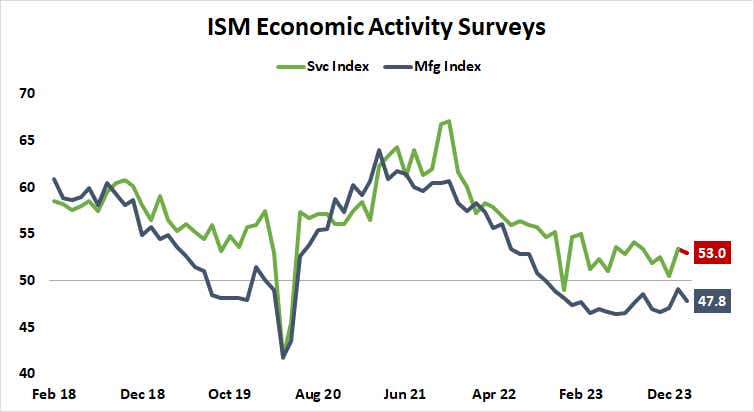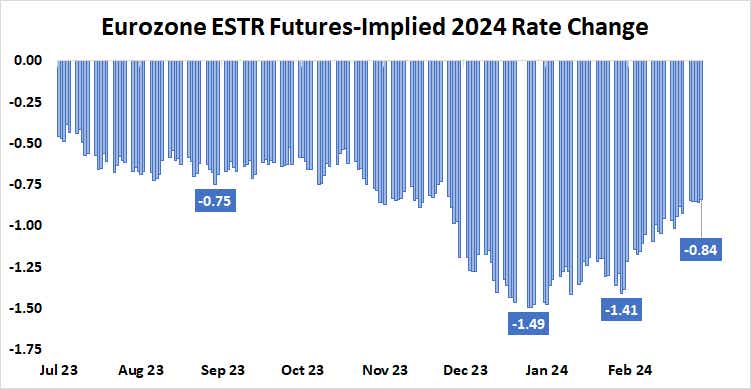Fed Chair Powell Testimony, U.S. ISM and Jobs Data, ECB Meeting: Macro Week Ahead

Fed Chair Powell Testimony, U.S. ISM and Jobs Data, ECB Meeting: Macro Week Ahead
By:Ilya Spivak
All eyes are on U.S. rate cut expectations as Fed Chair Powell testifies in Congress and key economic data arrives
- Investors focus on service-sector ISM and U.S. jobs data as Fed policy speculation churns.
- Fed Chair Powell may strike a hawkish tone in two days of Congressional testimony.
- The euro is in the balance as the ECB prepares to signal the start of interest rate cuts.
U.S. stock markets continued to roar higher last week.
The bellwether S&P 500 passed the leadership baton to the Nasdaq 100 having outperformed the tech-heavy index in the prior week. Signs of end to the hawkish re-pricing of the Federal Reserve interest rate cut path seem to have played the defining role.
First, the U.S. central bank’s favored PCE inflation gauge registered in line with expectations, easing worries about an upside surprise akin to the analog CPI report. Next, the manufacturing activity gauge from the Institute of Supply Management (ISM) fell short of expectations, showing the pace of contraction unexpectedly accelerated.
The 2024 policy path priced into Fed Funds futures promptly added 10 basis points (bps) to the expected rate cut tally in response. Shares rocketed higher, Treasury yields fell, gold prices jumped, and the U.S. dollar gave up some of the gains it scored against major currencies earlier in the week.
Below are macro waypoints that are likely to shape price action in the week ahead.
U.S. ISM non-manufacturing survey
The service sector ISM gauge is expected to show that the pace of expansion slowed a bit in February. Nevertheless, the downtick would put growth just a hair below January’s four-month high.
Services are a far larger part of the U.S. economy than manufacturing, so signs of resilience here may push back on last week’s dovish Fed repricing.

Federal Reserve Chair Powell testimony
Fed Chair Jerome Powell will sit for two days of back-to-back testimony before the U.S. Congress.
He begins with a sit-down in the House, then heads for a repeat performance in the Senate. Prepared remarks will be mostly unchanged from one outing to the next, with the key differences likely to show up in the Q&A portion of each exercise.
On balance, a hawkish tilt seems likely. U.S. economic data has mostly outperformed relative to baseline forecasts since the beginning of the year and inflation expectations priced into bond markets have moved up accordingly. On rate cuts, Powell is likely to reiterate that cuts are on the menu this year but talk down their urgency and scope.

European Central Bank (ECB) policy meeting
The euro hangs in the balance as the European Central Bank inches closer to cutting interest rates.
As it stands, three 25 bps cuts are fully priced in to appear by June, September, and December. A total of 84 bps in easing for 2024 is reflected in benchmark ESTR futures, implying a 64% probability of a fourth reduction by year-end.
Leading purchasing managers index (PMI) data shows that Eurozone economic activity shrank for an eighth consecutive month in February. Meanwhile, market-based measures of near-term inflation expectations seem to be anchored below the ECB’s 2% target. On balance, this seems to make room for some dovish stage-setting.

U.S. employment data
Job creation in the U.S. is expected to slow a bit in February. Still, an increase of 195,000 in nonfarm payrolls would land firmly within the broadly benign range of outcomes anchoring the labor market for the better part of a year. The jobless rate is seen holding steady at 3.7% yet again.
Absent a meaningful surprise on the downside, the numbers seem unlikely to stir dovish speculation in a lasting way. Still, the markets’ sensitivity to anything that might push Fed policy bets—one way or another—might make for sharp price swings in response to even most deviation from the forecasts.

Ilya Spivak, tastylive head of global macro, has 15 years of experience in trading strategy, and he specializes in identifying thematic moves in currencies, commodities, interest rates and equities. He hosts Macro Money and co-hosts Overtime, Monday-Thursday. @Ilyaspivak
For live daily programming, market news and commentary, visit tastylive or the YouTube channels tastylive (for options traders), and tastyliveTrending for stocks, futures, forex & macro.
Trade with a better broker, open a tastytrade account today. tastylive, Inc. and tastytrade, Inc. are separate but affiliated companies.
Options involve risk and are not suitable for all investors. Please read Characteristics and Risks of Standardized Options before deciding to invest in options.
tastylive content is created, produced, and provided solely by tastylive, Inc. (“tastylive”) and is for informational and educational purposes only. It is not, nor is it intended to be, trading or investment advice or a recommendation that any security, futures contract, digital asset, other product, transaction, or investment strategy is suitable for any person. Trading securities, futures products, and digital assets involve risk and may result in a loss greater than the original amount invested. tastylive, through its content, financial programming or otherwise, does not provide investment or financial advice or make investment recommendations. Investment information provided may not be appropriate for all investors and is provided without respect to individual investor financial sophistication, financial situation, investing time horizon or risk tolerance. tastylive is not in the business of transacting securities trades, nor does it direct client commodity accounts or give commodity trading advice tailored to any particular client’s situation or investment objectives. Supporting documentation for any claims (including claims made on behalf of options programs), comparisons, statistics, or other technical data, if applicable, will be supplied upon request. tastylive is not a licensed financial adviser, registered investment adviser, or a registered broker-dealer. Options, futures, and futures options are not suitable for all investors. Prior to trading securities, options, futures, or futures options, please read the applicable risk disclosures, including, but not limited to, the Characteristics and Risks of Standardized Options Disclosure and the Futures and Exchange-Traded Options Risk Disclosure found on tastytrade.com/disclosures.
tastytrade, Inc. ("tastytrade”) is a registered broker-dealer and member of FINRA, NFA, and SIPC. tastytrade was previously known as tastyworks, Inc. (“tastyworks”). tastytrade offers self-directed brokerage accounts to its customers. tastytrade does not give financial or trading advice, nor does it make investment recommendations. You alone are responsible for making your investment and trading decisions and for evaluating the merits and risks associated with the use of tastytrade’s systems, services or products. tastytrade is a wholly-owned subsidiary of tastylive, Inc.
tastytrade has entered into a Marketing Agreement with tastylive (“Marketing Agent”) whereby tastytrade pays compensation to Marketing Agent to recommend tastytrade’s brokerage services. The existence of this Marketing Agreement should not be deemed as an endorsement or recommendation of Marketing Agent by tastytrade. tastytrade and Marketing Agent are separate entities with their own products and services. tastylive is the parent company of tastytrade.
tastyfx, LLC (“tastyfx”) is a Commodity Futures Trading Commission (“CFTC”) registered Retail Foreign Exchange Dealer (RFED) and Introducing Broker (IB) and Forex Dealer Member (FDM) of the National Futures Association (“NFA”) (NFA ID 0509630). Leveraged trading in foreign currency or off-exchange products on margin carries significant risk and may not be suitable for all investors. We advise you to carefully consider whether trading is appropriate for you based on your personal circumstances as you may lose more than you invest.
tastycrypto is provided solely by tasty Software Solutions, LLC. tasty Software Solutions, LLC is a separate but affiliate company of tastylive, Inc. Neither tastylive nor any of its affiliates are responsible for the products or services provided by tasty Software Solutions, LLC. Cryptocurrency trading is not suitable for all investors due to the number of risks involved. The value of any cryptocurrency, including digital assets pegged to fiat currency, commodities, or any other asset, may go to zero.
© copyright 2013 - 2025 tastylive, Inc. All Rights Reserved. Applicable portions of the Terms of Use on tastylive.com apply. Reproduction, adaptation, distribution, public display, exhibition for profit, or storage in any electronic storage media in whole or in part is prohibited under penalty of law, provided that you may download tastylive’s podcasts as necessary to view for personal use. tastylive was previously known as tastytrade, Inc. tastylive is a trademark/servicemark owned by tastylive, Inc.